Abstract
Transoral thyroidectomy using the vestibular approach has achieved excellent cosmetic outcomes without leaving any visible scars. However, concerns have been raised on how to prevent complications, such as skin perforation and anterior jugular vein injury, especially in the learning period. This is because working space is generally created via blind and blunt dissection using a blunt dilator through small vestibular incisions unfamiliar to beginners. Herein, we explain an intraoperative real-time ultrasound technique employed in transoral thyroidectomy to safely elevate a skin flap while avoiding any damage to the flap and anterior jugular vein in the learning period.
Various procedures of remote-access thyroidectomy (RAT), including axillary, breast, anterior chest, postauricular, and transoral approaches, have been developed to minimize the formation of anterior neck scar by making incisions in unexposed body parts [1-8]. Among these, the transoral thyroidectomy vestibular approach does not involve any skin incision. Thus, it has been regarded as true natural orifice transluminal endoscopic surgery for thyroidectomy. Not only does this technique allow total thyroidectomy to be easily performed, due to its midline approach, offering equal access to both thyroid lobes, but it is also less invasive than other RAT procedures due to the requirement of a relatively smaller working space [7-9].
In transoral thyroidectomy, working space creation and skin flap elevation are generally performed via blunt dissection using the hydrodissection technique and a blunt dilator without clear identification of the subplatysmal plane. If the flap is too thin, it can result in skin perforation or dimpling [8-11]. Conversely, if the dissection plane is too deep, the digastric, mylohyoid, and strap muscles as well as the superficial vessels may get injured, resulting in bleeding and carbon dioxide (CO2) embolism [9,11].
The abovementioned risks have raised concerns over the possibility of precise flap elevation in the subplatysmal plane through small vestibular incisions, representing a huge hindrance to performing transoral thyroidectomy, particularly for novice surgeons. To solve this issue, we strived to find the correct plane during the hydrodissection process so that the blunt dilator could be advanced through the right plane. In this report, we explain an intraoperative real-time ultrasound technique employed in transoral thyroidectomy to safely elevate a skin flap beneath the subplatysmal layer while avoiding any damage to the flap and anterior jugular vein in the learning period.
From December 2019 to February 2021, 10 patients with thyroid nodules received transoral thyroidectomy. All cases were performed by one novice head and neck surgeon without prior endoscopic or robotic experience.
The submental area is a triangular area bounded posteriorly by the mylohyoid muscle, laterally by the anterior belly of the digastric muscle, superiorly by the symphysis menti, and inferiorly by the hyoid bone. The digastric (anterior belly), mylohyoid, geniohyoid, and genioglossus muscles as well as the subcutaneous tissue could be observed in transverse ultrasound views of the submental area (Fig. 1). Besides, the following structures were visualized via transverse ultrasonography of the lower anterior neck: subcutaneous tissue, strap muscles, thyroid cartilage, common carotid artery, thyroid, and trachea (Fig. 2).
The patient was placed in a supine position on the operating table under general anesthesia. After orotracheal intubation, the neck was extended using a shoulder pillow, and the oral cavity was disinfected with a dilute povidone-iodine solution. After prepping and draping the patient according to previous guidelines, a 2-cm horizontal incision above the inferior labial frenulum and two lateral incisions close to the oral commissure were marked. Following central mucosal incision, the dissection proceeded over the periosteum of the mandible.
Beyond the mental protuberance, we first opened up a working space using Kelly forceps and real-time ultrasonography to ensure that the layer was neither too shallow nor too deep (Supplementary Video 1, demonstrating the intraoperative use of ultrasonography as a guiding tool for working space creation). Then, under ultrasound guidance, a Veress needle was inserted into the initial working space, with its tip positioned near the subplatysmal layer. To initiate hydrodissection, 0.05 mL of 0.1% epinephrine diluted in 20 mL of normal saline (1:400000) was injected through the Veress needle into the subplatysmal plane along the central and lateral axes under ultrasound visualization of the submental area. Via ultrasonography, we identified the plane of the subplatysmal layer and confirmed whether the needle tip was placed in the proper plane for hydrodissection (Fig. 3). Afterward, ultrasound-guided hydrodissection was continued inferiorly to the level of the sternal notch and laterally to the sternocleidomastoid muscle. Subsequently, blunt dissection was performed by advancing a Hegar dilator to extend the working space. A blunt-tip, 12-mm trocar was inserted into the central incision site for subsequent placement of a rigid, 10-mm, 30° endoscope. Then, CO2 insufflation was initiated and maintained at 6 mm Hg pressure; additionally, two trocars (5 mm diameter) were inserted through the lateral oral incisions to introduce endoscopic instruments. Doppler ultrasonography, if present, can facilitate in identifying and marking large superficial vessels in the submental or anterior neck area to prevent vessel injury during blunt dissection and trocar placement (Fig. 4). Upon identification of the appropriate dissection plane in the anterior neck, a skin flap was elevated in the subplatysmal plane using laparoscopic dissectors, harmonic curved shears, and a hook-tip monopolar electrocautery device under endoscopic view. Finally, the working space was widened to the level of the sternal notch inferiorly and to the sternocleidomastoid muscle laterally.
The anterior jugular vein and strap muscle fascia could be well preserved in all cases during the ultrasound-guided flap elevation (Fig. 5). Moreover, no skin injury, such as dimpling, burn, or perforation, occurred during the procedure.
In transoral thyroidectomy, the incidence of skin flap perforation in the anterior neck, lower lip, or chin ranges is 0%-4.2% [11]. Most of it occurs when the surgeons are beginners who are not experienced to perform transoral vestibular approach. In severe cases, skin perforation may result in skin necrosis requiring reconstruction using a local rotation flap [8,9,11]. This is most likely to happen in the central neck, where the platysma muscle is absent and the skin is thin. Therefore, care should be taken to not perforate the skin when performing flap elevation.
An anatomical study on trocar pathway transition in transoral thyroidectomy revealed that the median trocar enters the subplatysmal plane after penetrating the superficial fascia of the chin and neck, where the left and right platysma bundles are absent [12]. The platysma muscle is a thin bilateral structure extending from the superficial musculoaponeurotic system of the face to the clavicle and lying within the subcutaneous tissue of the neck. There are numerous variations in the anatomy of the platysma muscle in the submental region. Besides, the subcutaneous tissue of the submental and midline anterior neck regions, it generally contains fat lying between the medial edges of the platysma. Thus, no clear structure can be visually identified, and it is difficult to confirm the skin flap’s cross-sectional view through small vestibular incisions.
Intraoperative ultrasonography visualizes the orientation of the subcutaneous layers and adjacent muscles and vessels. Moreover, it enables clinicians to easily differentiate the subcutaneous layer embracing the platysma from the other layers (i.e., the digastric and mylohyoid muscles), thereby making initial dissection by Kelly forceps and hydrodissection with diluted epinephrine more precise and contributing to flap elevation in a more reliable plane. Even in some cases where the platysma is underdeveloped and consequently may be indistinguishable on ultrasonography, hydrodissection can be performed directly above the digastric and mylohyoid muscles, which helps elevate a skin flap of adequate thickness.
CO2 embolism, a fatal complication of transoral thyroidectomy, usually occurs when the anterior jugular vein is torn during skin flap elevation for working space creation, allowing CO2 to enter the vessel [13]. In a study by Hong, et al. [14], CO2 embolism occurred immediately after central oral trocar placement and CO2 insufflation. This complication may occur following injury to the superficial vessels while bluntly inserting a long dilator. Hence, special care should be exercised not to injure the vessels when performing such procedure. Doppler ultrasonography can be employed to identify large vessels in the submental or anterior neck area, whose directions and locations can then be marked on the skin so that blunt dissection using a dilator can be safely performed with no injury to large superficial vessels and, as a result, a diminished risk of CO2 embolism.
To the best of our knowledge, this is the first report of ultrasound-guided flap elevation for transoral thyroidectomy. Some surgeons may insist that hydrodissection or ultrasonography is not necessary in the flap elevation procedure in transoral thyroidectomy. But as we mentioned, it can be beneficial for beginner surgeons to get used to flap elevation with blind condition in the learning period and to prevent complications that may occur in the early learning stages of the new surgical technique. It is believed that this was possible because the novice surgeon became familiar with the flap elevation mechanism and anatomy while safely raising the appropriate flap thickness using ultrasonography in the early learning stage. We believe that skin flap elevation under ultrasound guidance can play an adjuvant role for beginner surgeons in transoral thyroidectomy; however, further studies with larger clinical series are required to confirm the efficacy of this technique.
In conclusion, the application of ultrasonography to skin flap elevation in transoral thyroidectomy could be a feasible method for identifying the subplatysmal layer and superficial vessels, particularly for novice surgeons, while preventing complications, such as CO2 embolism, bleeding, and skin flap injuries.
Supplementary Material
The Data Supplement is available with this article at https://doi.org/10.3342/kjorl-hns.2021.01053.
ACKNOWLEDGMENTS
This work was supported by a National Research Foundation of Korea (NRF) grant funded by the Korea government (MSIP; Ministry of Science, ICT & Future Planning) (No. NRF-2019R1G1A1100265). The interpretation and conclusions contained herein do not represent those of the NRF, Korean government, or MSIP.
Notes
Author Contribution
Conceptualization: Dong Won Lee. Data curation: all authors. Formal analysis: Dong Won Lee. Funding acquisition: Dong Won Lee. Methodology: Dong Won Lee, Kyung Tae. Project administration: Dong Won Lee. Visualization: Dong Won Lee, Jeong Kyu Kim, Seung Heon Shin. Writing—original draft: Dong Won Lee. Writing—review & editing: all authors.
REFERENCES
1. Tae K, Ji YB, Song CM, Ryu J. Robotic and endoscopic thyroid surgery: Evolution and advances. Clin Exp Otorhinolaryngol. 2019; 12(1):1–11.

2. Terris DJ, Singer MC, Seybt MW. Robotic facelift thyroidectomy: II. Clinical feasibility and safety. Laryngoscope. 2011; 121(8):1636–41.

3. Tae K, Ji YB, Jeong JH, Lee SH, Jeong MA, Park CW. Robotic thyroidectomy by a gasless unilateral axillo-breast or axillary approach: Our early experiences. Surg Endosc. 2011; 25(1):221–8.

4. Tae K, Ji YB, Cho SH, Lee SH, Kim DS, Kim TW. Early surgical outcomes of robotic thyroidectomy by a gasless unilateral axillobreast or axillary approach for papillary thyroid carcinoma: 2 years’ experience. Head Neck. 2012; 34(5):617–25.

5. Sung ES, Ji YB, Song CM, Yun BR, Chung WS, Tae K. Robotic thyroidectomy: Comparison of a postauricular facelift approach with a gasless unilateral axillary approach. Otolaryngol Head Neck Surg. 2016; 154(6):997–1004.
6. Lee DW, Ko SH, Song CM, Ji YB, Kim JK, Tae K. Comparison of postoperative cosmesis in transaxillary, postauricular facelift, and conventional transcervical thyroidectomy. Surg Endosc. 2020; 34(8):3388–97.

7. Anuwong A. Transoral endoscopic thyroidectomy vestibular approach: A series of the first 60 human cases. World J Surg. 2016; 40(3):491–7.

8. Tae K, Lee DW, Song CM, Ji YB, Park JH, Kim DS, et al. Early experience of transoral thyroidectomy: Comparison of robotic and endoscopic procedures. Head Neck. 2019; 41(3):730–8.

9. Tae K, Ji YB, Song CM, Park JS, Park JH, Kim DS. Safety and efficacy of transoral robotic and endoscopic thyroidectomy: The first 100 cases. Head Neck. 2020; 42(2):321–9.

10. Bakkar S, Al Hyari M, Naghawi M, Corsini C, Miccoli P. Transoral thyroidectomy: A viable surgical option with unprecedented complications-a case series. J Endocrinol Invest. 2018; 41(7):809–13.

11. Tae K. Complications of transoral thyroidectomy: Overview and update. Clin Exp Otorhinolaryngol. 2021; 14(2):169–78.

12. Celik S, Makay O, Yoruk MD, Bayzit Kocer I, Ozdemir M, Kilic KD, et al. A surgical and anatomo-histological study on transoral endoscopic thyroidectomy vestibular approach (TOETVA). Surg Endosc. 2020; 34(3):1088–102.

Fig. 1.
Transverse ultrasound images of the submental region. 1, subcutaneous tissue; 2, anterior belly of the digastric muscle; 3, mylohyoid muscle; 4, geniohyoid muscle; 5, genioglossus muscle; 6, sublingual gland.
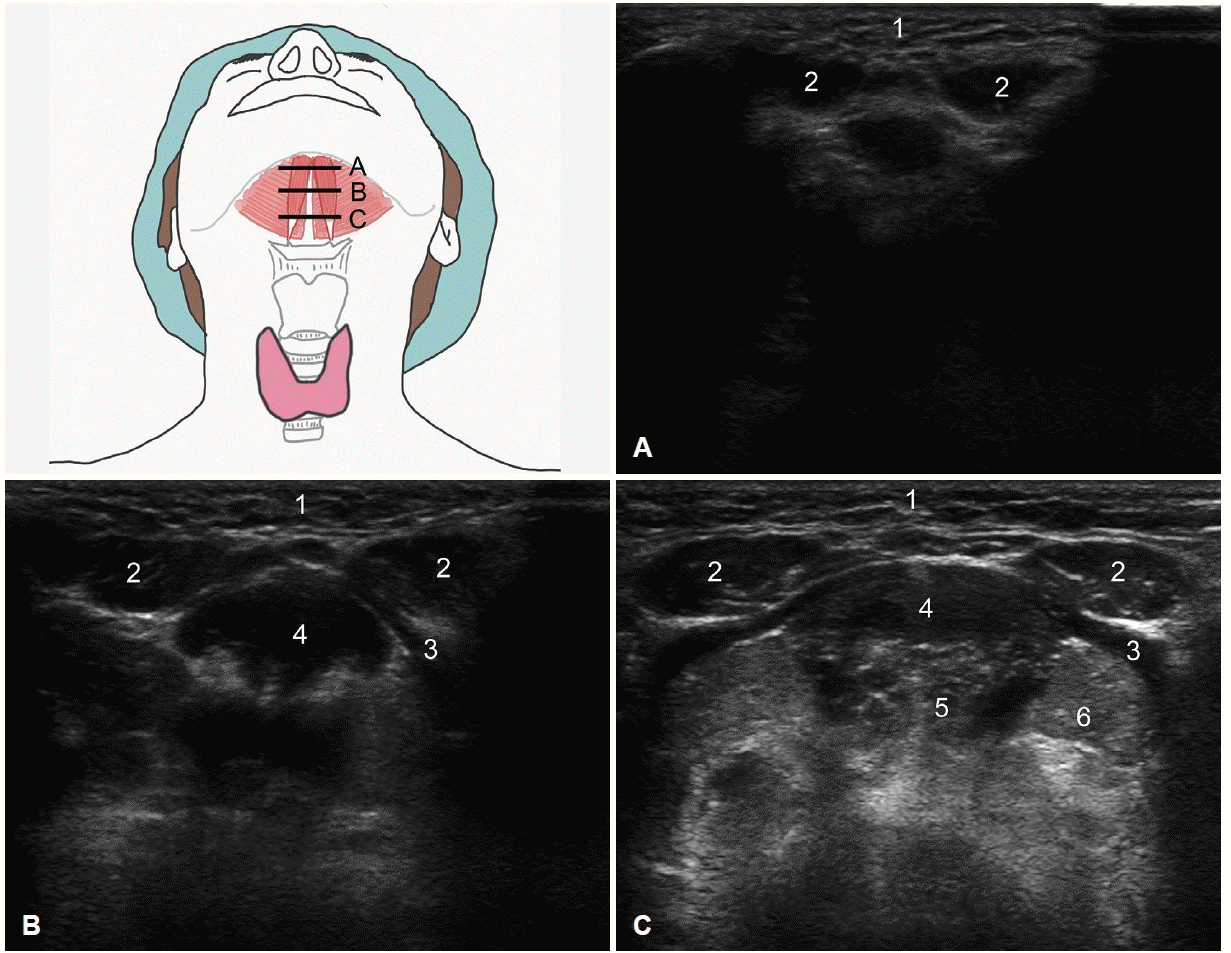
Fig. 2.
Transverse ultrasound images of the infrahyoid region. 1, subcutaneous tissue; 2, strap muscles; 3, thyroid cartilage; 4, common carotid artery; 5, thyroid gland; 6, trachea.
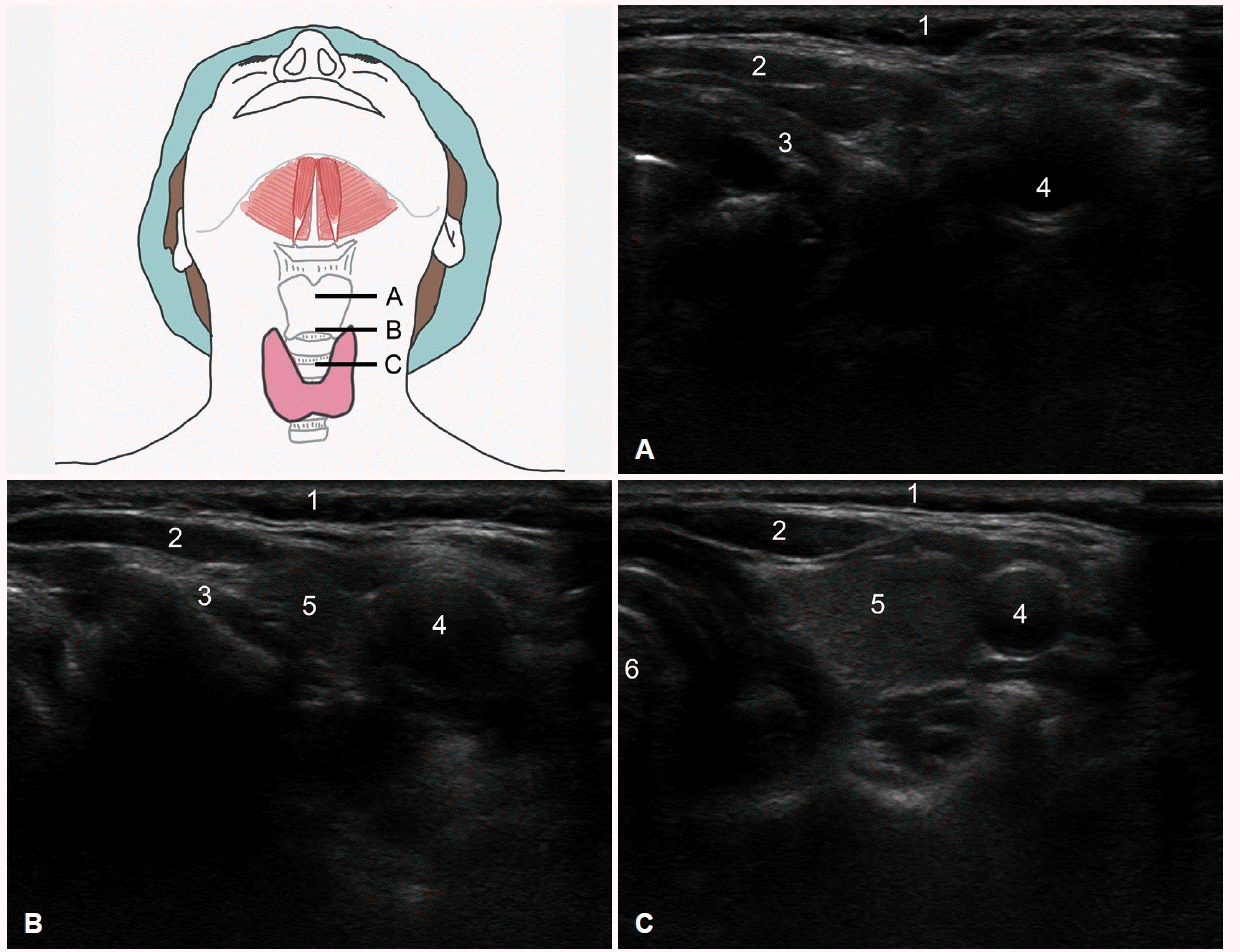
Fig. 3.
Hydrodissection under ultrasound guidance. A and B: A Veress needle is inserted through the central incision, with its tip positioned in the proper dissection plane under ultrasound guidance. C and D: The subcutaneous layer is identified in the submental area, followed by hydrodissection under ultrasound guidance. Arrow, needle tip; Dotted circle, hydrodissected area; 1, anterior belly of the digastric muscle; 2, mylohyoid muscle; 3, geniohyoid muscle.
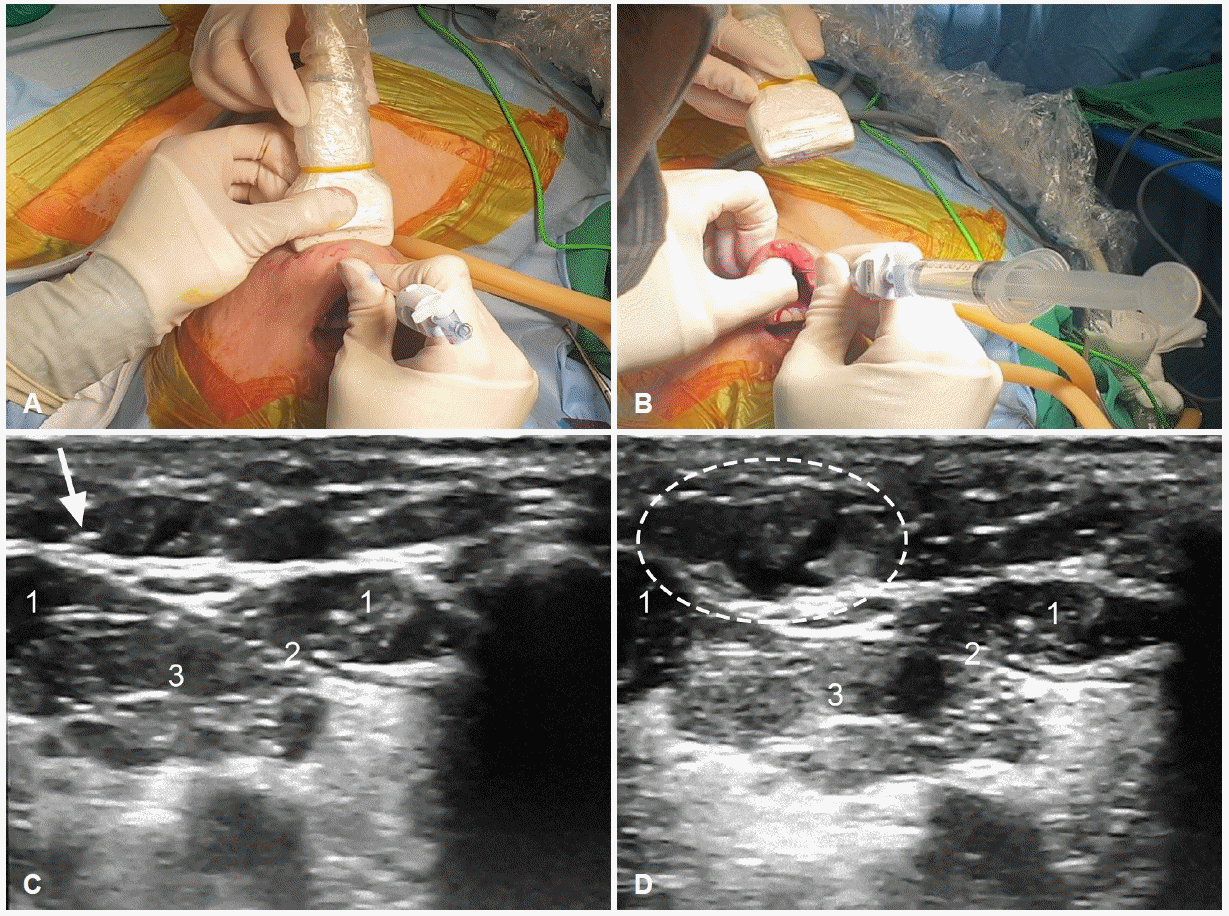




 PDF
PDF Citation
Citation Print
Print




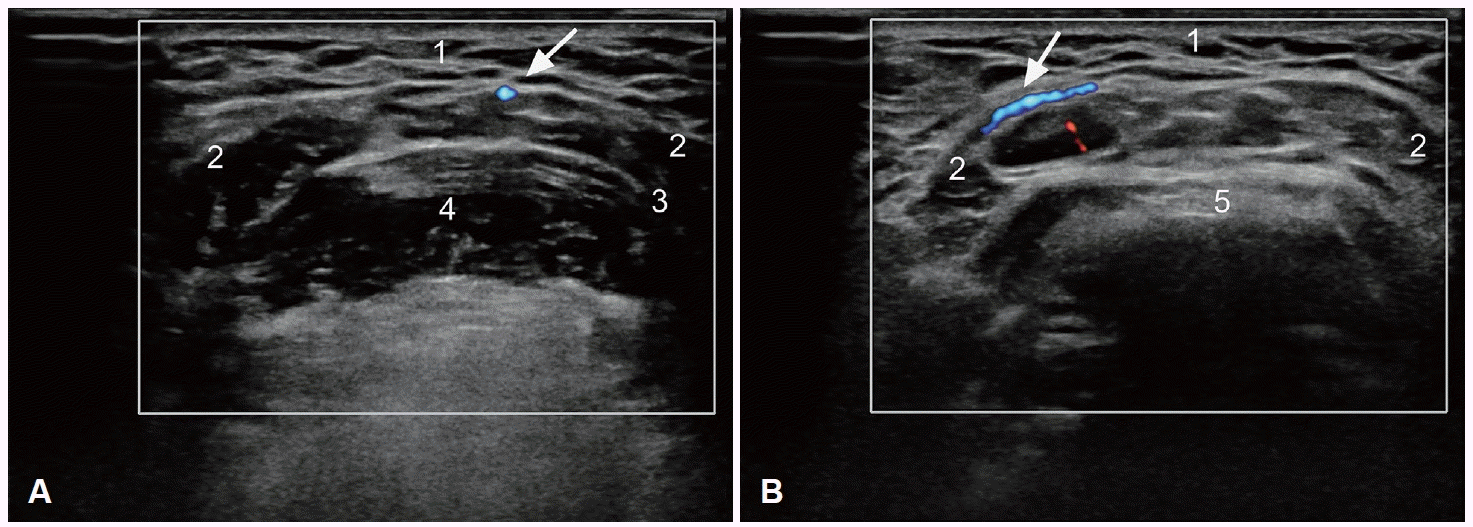
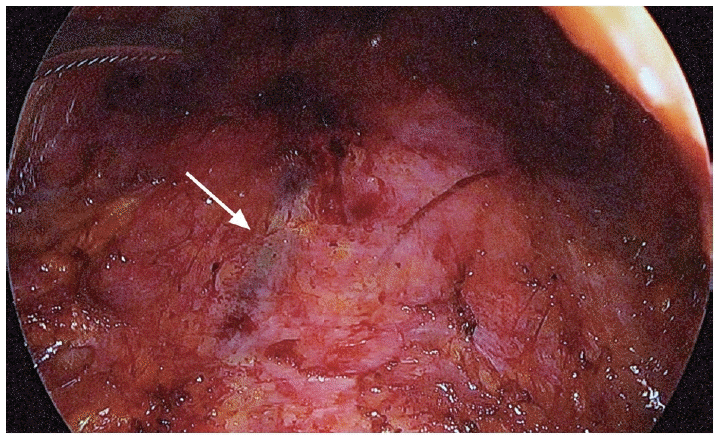
 XML Download
XML Download